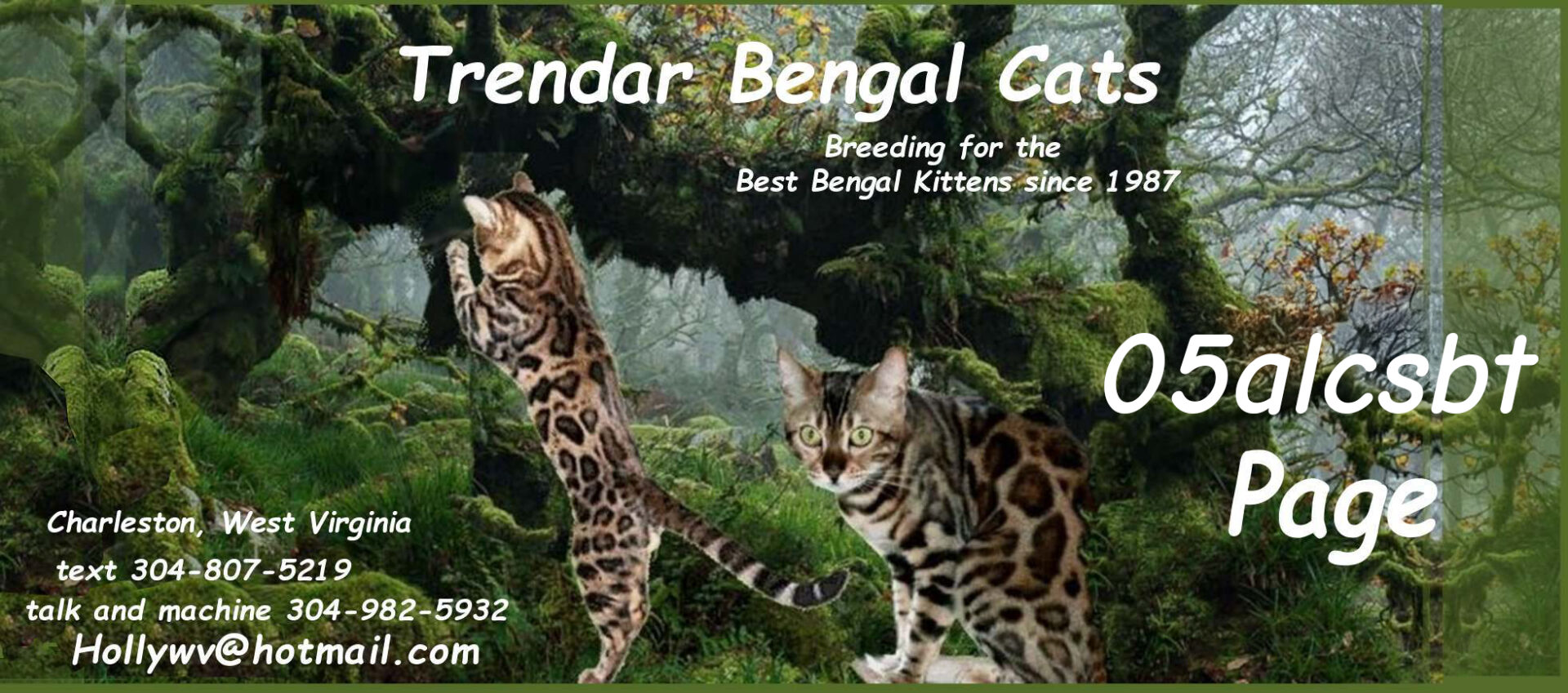
Understanding %=F and
ABC's of TICA Pedigrees
LINKS to the many pages on this website
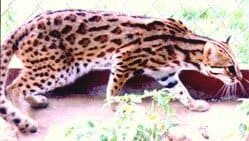
Bengal History has to begin with the wild cats used in their creation
Trendar Bengals has owned 3 leopard cats
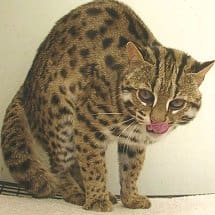
Leopard Cat
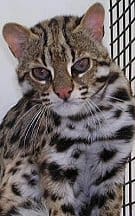
ASIAN LEOPARD CAT A Small Forest Dwelling Leopard
Today's foundation breeders are dedicated to long term commitment of creating the most wild looking pet that is also predictable, playful, confident, active, and loves to curl in your lap and purr its self to sleep.
The Bengals courage gives it the easy going nature to quickly accept new people and other pets. Bengals stay playful through out their life. They like to play in water and often play fetch. Like any animal early experiences are important in developing a healthy attitude toward life.
Any cat raised in a cage with little exposure to new sights, sounds, activities, other animals and people will be shy and defensive. It is difficult to teach old dogs, or cats, new tricks.
The first generation crosses, referred to as
F1 and F2 are not your typical house cat.
They are necessary in creating the Domestic Bengal
To visit one home that keeps 2 of these beautiful,
active creatures for pets, please visit
Granny Wicked and Ralph's Place.
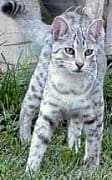
Spotlite F1 Silver Sabbath
What is a small forest dwelling leopard cat??
The Asian Leopard Cat (here in referred to as ALC)
is the backbone of the Bengal breed. The Domestic Bengal gets it's name from the ALC's scientific name Felis Bengalensis.
ALC's come in a wide range of colorations from light gold to sandy brown
to rich orange. Some have spots while others have rosettes.
The southern subspecies's, as in above photo, are small and lean, weighing from 8 to 14 pounds.
There are several small subspecies very common through out the jungles of Asia.
Euptilura Subspecies, Has a LOT to offer Genetically
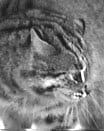
Euptilura
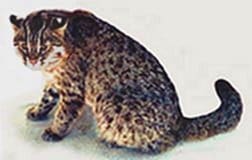
IDO NAQIT OF TRENDAR,
Ido is of the Euptilura subspecies of Felis Bengalensis,
outwardly quite different from smaller subspecies which is more commonly used in the creation of the Domestic Bengal breed.
Euptilura are usually covered with a rosette pattern, they are often more
than twice as large as many southern subspecies, with a dense short coat, heavy bone and muscling, and shorter, thick tail. These traits are necessary for
survival in the cold northern regions where they originate. The Euptilura
has earned the nick name of Amur, for the Amur region of Russia where they are commonly found.
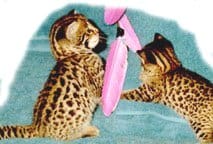
IDO NAQIT adds wonderful patterns with large well separated spots
and rosettes, as seen here and in other F1 cats shown in my breeding
section. Euptilura add larger size and generally a more easy going
temperament Their dense soft coat, thick low slung tail, wonderful
heads with long faces and tiny ears
give IDO' descendants a cutting edge on wild looks and larger size
Laws and Licenses
To own one ALC does not require a license from the United States Dept of Interior, USDI, or USDA, United States Dept of Agriculture, unless it is deemed an endangered subspecies.
Owning an ALC is not like owning a Domestic Bengal cat.
They are elusive and timid. They do not like noise and unfamiliar changes upset them.
Most homes are not suitable to provide the security and comfort needed by a wild cat. Many city, county or state laws regulating the keeping of a wild animal. Owning an ALC does not mean you will get kittens. Not all ALC recognize or breed domestic cats, or their own kind. While Electro Ejaculation is a relatively simple procedure, conception is not. Any time an animal is anesthetized there is the risk of death. Female cats ovulate after multiple stimulation by the spines on the males penis. Drugs can be used to encourage ovulation, but they are unreliable and can cause a uterine infection resulting in loss any possible fetus and loss of the female .
F Numbers
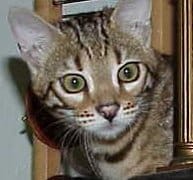
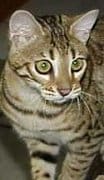
this is Trendar F2 Starla, a Female Kitten
F refers to Foundation Generation cross between ALC and domestic. This F number is for quick reference. TICA registration numbers are used to explain more clearly the ancestry of Foundation cats.
F1, A1T is the first generation cross, 50% or higher ALC blood
Most males are sterile, females are bred to domestic SBT Benglas
F2 is the second dilution of wild blood... Most males are sterile
F3 is the third dilution.. some males are fertile
F4 is usually the last dilution needed to produce Bengals with fertile males and females. A few F4 males are not fertile.
4th Generation from non domestic ancestor can be AOT; BOT; COT or SBT. this depends on whether only Bengals were used in the creation of the line, or whether an Egyptian Mau or other domestic breeds was used with the Foundation Bengals.
4th generation, using Bengal to Bengal breeding produces SBT.
TICA registration numbers tell a lot more about a Bengal's Heritage than the simple use of Foundation numbers
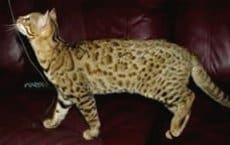
ABC's of TICA Pedigrees
Each cat registered with TICA has it's own
unique registration number.
these have changed since writing and will be updates as soon as time allows
Understanding the meaning of the different characters in the registration number will give you an idea of the cat's ancestry.
If the cat is not SBT, then the first character of the prefix will be one of the following:
A- This cat has a parent registered as another breed or not registered (may be wild or domestic)
B- This cat has at least one grandparent that is another breed.
C- This cat has a great-grandparent that is another breed
0- This cat has an unregistered or unknown cat in it's 3 generation pedigree.
the second character will be one of the following:
1- This cat has an unregistered or unknown parent ( in Bengals this includes the wild ancestor)
2- This cat has at least one unregistered or unknown grandparent
3- This cat has at least one unregistered or non-domestic great grandparent
0- This cat has no unregistered or non-domestic cats in the three generation pedigree, but has cats registered as another breed within three generations.
this is a  BOT, F4, Silver Bengal
BOT, F4, Silver Bengal
The third character of the registration code will be
T- (Traditional) Only the breed in question within a three generation pedigree
V- (Variant) Crosses outside the breed but within the group within a three-generation pedigree
P- (Permissible) Crosses outside the breed or breed group which are permitted by the breeding program which has been established for the breed
N- (Non-Permissible) Crosses outside the breed or breed group which are not among those which are specifically allowed by the breeding program in progressing to established Championship statue.
Several people have B0T Bengals " grandsire/dam is E. Mau or other accepted non Bengal breed." now their kittens will be registered as CON.
If you breed a CON to SBT; or CON to CON you will get an SBT.
The six numbers following the prefix indicate the cat's birth date month, day, year
The last three numbers are number of the cats currently registered with TICA that were born the same day as your cat, could be any breed.
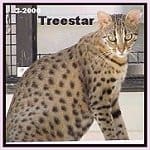
Bengal Registries in the USA;
TICA; The International Cat Association
TICA is a Genetic Registry, for keeping track of the heritage of pedigreed cats.
There are TICA clubs in most states in the USA, and in many other countries.
In 1985 TICA accepted the Brown Spotted Bengal Cat for entry into their cat shows in their New Breed and Color (NBC) Class.
In early 1991 TICA accepted Brown Spotted Tabby SBT Bengals for showing for full Championship.
In 1994 TICA accepted the Marbled Pattern on Bengals along with the Spotted Pattern in traditional Brown Tabby color and in Seal Mink, Seal Sepia and Seal Lynx Point colors.
In 2004 TICA accepted the Silver color for show Championship.
ACFA; American Cat Fanciers Association
ACFA accepted Bengals for registry in the early 90's.
ACFA accepted the SBT Bengal for Championship Show status at their ACFA shows in May of 1998.
ACFA accepted the breed standards, colors and patterns recognized by TICA.
UFO; United Feline Organization, 1995 Accepts any color Bengal that is genetically possible, including those with NBC status in TICA and ACFA.
Silver, Blue and Melanistic or Black.
CFA; The Cat Fanciers Association, 2018, finally CFA accepred Bengals for showing, with a pedigree showing the cat's parents are at least 5 generations from the wild Asoian Leopard Cat.
INTERNATIONALLY
CANADA - TICA, (CCA) Canadian Cat Association. accepted for Championship 1993
ENGLAND - TICA, (GCCF) The Governing Council of Cat Fancy (1997)
EUROPE; SOUTH AMERICA AUSTRALIA and JAPAN; TICA and UFO
for more info about our Bengals
ENJOY THE REST OF OUR INFO PAGES
Home / Male Bengal Cats / Female Bengal Cats /
Bengal Kittens Available for sale
